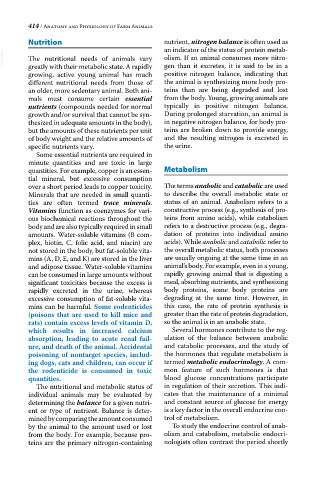Page 429 - Anatomy and Physiology of Farm Animals, 8th Edition
P. 429
414 / Anatomy and Physiology of Farm Animals
Nutrition nutrient, nitrogen balance is often used as
an indicator of the status of protein metab-
VetBooks.ir The nutritional needs of animals vary olism. If an animal consumes more nitro-
gen than it excretes, it is said to be in a
greatly with their metabolic state. A rapidly
growing, active young animal has much positive nitrogen balance, indicating that
different nutritional needs from those of the animal is synthesizing more body pro-
an older, more sedentary animal. Both ani- teins than are being degraded and lost
mals must consume certain essential from the body. Young, growing animals are
nutrients (compounds needed for normal typically in positive nitrogen balance.
growth and/or survival that cannot be syn- During prolonged starvation, an animal is
thesized in adequate amounts in the body), in negative nitrogen balance, for body pro-
but the amounts of these nutrients per unit teins are broken down to provide energy,
of body weight and the relative amounts of and the resulting nitrogen is excreted in
specific nutrients vary. the urine.
Some essential nutrients are required in
minute quantities and are toxic in large
quantities. For example, copper is an essen- Metabolism
tial mineral, but excessive consumption
over a short period leads to copper toxicity. The terms anabolic and catabolic are used
Minerals that are needed in small quanti- to describe the overall metabolic state or
ties are often termed trace minerals. status of an animal. Anabolism refers to a
Vitamins function as coenzymes for vari- constructive process (e.g., synthesis of pro-
ous biochemical reactions throughout the teins from amino acids), while catabolism
body and are also typically required in small refers to a destructive process (e.g., degra-
amounts. Water‐soluble vitamins (B com- dation of proteins into individual amino
plex, biotin, C, folic acid, and niacin) are acids). While anabolic and catabolic refer to
not stored in the body, but fat‐soluble vita- the overall metabolic status, both processes
mins (A, D, E, and K) are stored in the liver are usually ongoing at the same time in an
and adipose tissue. Water‐soluble vitamins animal’s body. For example, even in a young,
can be consumed in large amounts without rapidly growing animal that is digesting a
significant toxicities because the excess is meal, absorbing nutrients, and synthesizing
rapidly excreted in the urine, whereas body proteins, some body proteins are
excessive consumption of fat‐soluble vita- degrading at the same time. However, in
mins can be harmful. Some rodenticides this case, the rate of protein synthesis is
(poisons that are used to kill mice and greater than the rate of protein degradation,
rats) contain excess levels of vitamin D, so the animal is in an anabolic state.
which results in increased calcium Several hormones contribute to the reg-
absorption, leading to acute renal fail- ulation of the balance between anabolic
ure, and death of the animal. Accidental and catabolic processes, and the study of
poisoning of nontarget species, includ- the hormones that regulate metabolism is
ing dogs, cats and children, can occur if termed metabolic endocrinology. A com-
the rodenticide is consumed in toxic mon feature of such hormones is that
quantities. blood glucose concentrations participate
The nutritional and metabolic status of in regulation of their secretion. This indi-
individual animals may be evaluated by cates that the maintenance of a minimal
determining the balance for a given nutri- and constant source of glucose for energy
ent or type of nutrient. Balance is deter- is a key factor in the overall endocrine con-
mined by comparing the amount consumed trol of metabolism.
by the animal to the amount used or lost To study the endocrine control of anab-
from the body. For example, because pro- olism and catabolism, metabolic endocri-
teins are the primary nitrogen‐containing nologists often contrast the period shortly

